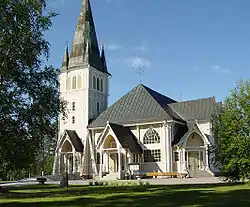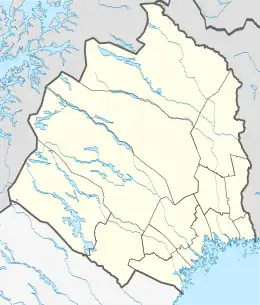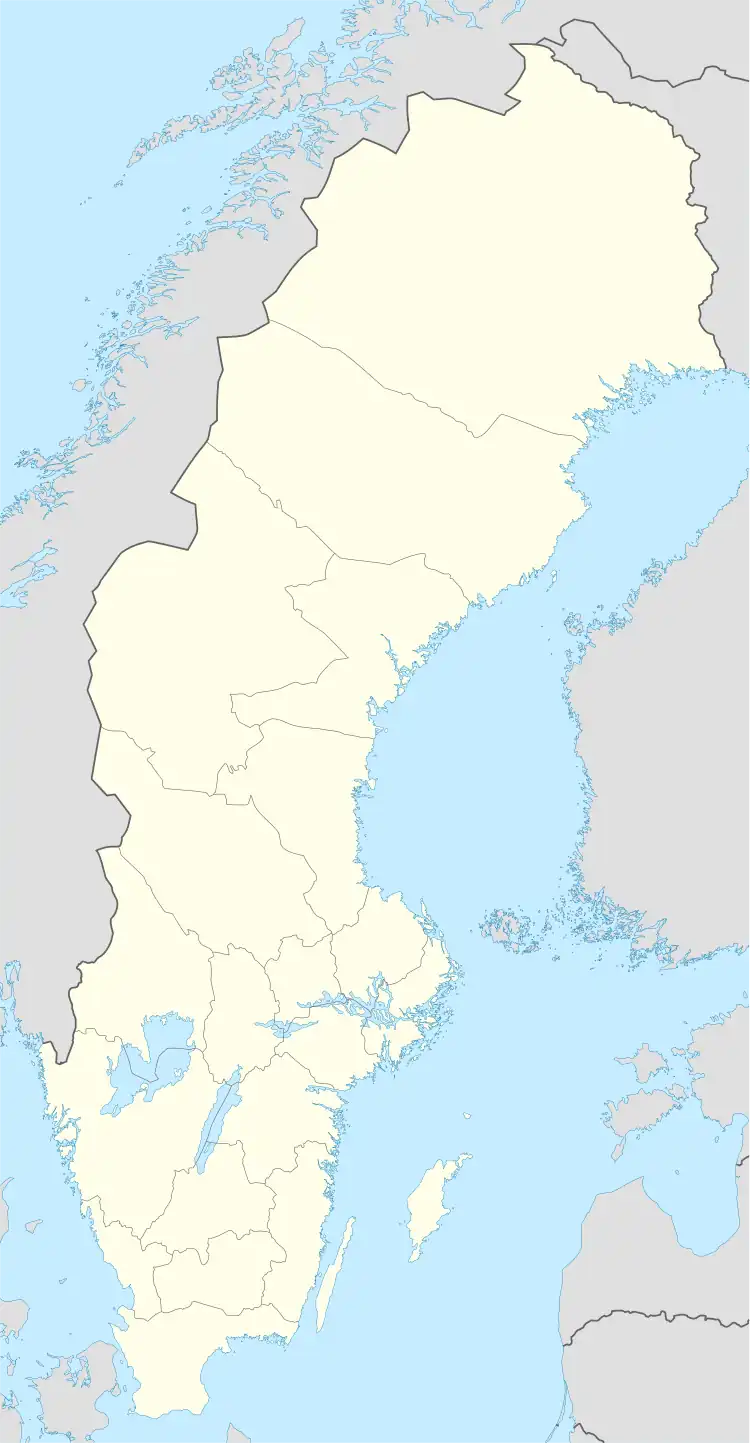Arvidsjaur
Árviesjávrrie | |
|---|---|
 Arvidsjaur Church | |
 Arvidsjaur  Arvidsjaur | |
| Coordinates: 65°35′N 19°10′E / 65.583°N 19.167°E | |
| Country | Sweden |
| Province | Lapland |
| County | Norrbotten County |
| Municipality | Arvidsjaur Municipality |
| Area | |
| • Total | 4.67 km2 (1.80 sq mi) |
| Population (31 December 2010)[1] | |
| • Total | 4,635 |
| • Density | 993/km2 (2,570/sq mi) |
| Time zone | UTC+1 (CET) |
| • Summer (DST) | UTC+2 (CEST) |
Arvidsjaur (Swedish: [ˈǎrːvɪdsjaʊr];[2] Ume Sami: Árviesjávrrie; Pite Sami: Árvehávvre) is a locality and the seat of Arvidsjaur Municipality in Norrbotten County, province of Lapland, Sweden with 4,635 inhabitants in 2010.[1]
Arvidsjaur is a center for the European car industry. During the winter months, major car-manufacturers perform arctic trials in the Arvidsjaur Municipality. The town also fosters tourism by offering snowmobile tours, trekking, skiing, fishing and dogsled rides.
Sport
The following sports clubs are in Arvidsjaur:
Transport
Arvidsjaur has established rail and road networks, and also has an airport, with daily flights to Stockholm, and seasonal ones to destinations in Germany. The railway Inlandsbanan has only tourist trains in the summer. There are buses to Gällivare, Östersund, Skellefteå, Piteå, Luleå and more local places.
Climate
Arvidsjaur has a subarctic climate that is dominated by the long winters and briefly interrupted by moderately warm but very bright summers due to its northerly latitude.
| Climate data for Arvidsjaur (2002–2022 averages); extremes since 1996 | |||||||||||||
|---|---|---|---|---|---|---|---|---|---|---|---|---|---|
| Month | Jan | Feb | Mar | Apr | May | Jun | Jul | Aug | Sep | Oct | Nov | Dec | Year |
| Record high °C (°F) | 6.9 (44.4) |
7.3 (45.1) |
9.7 (49.5) |
17.9 (64.2) |
27.1 (80.8) |
30.2 (86.4) |
32.5 (90.5) |
29.3 (84.7) |
23.2 (73.8) |
20.1 (68.2) |
10.7 (51.3) |
7.8 (46.0) |
32.5 (90.5) |
| Mean maximum °C (°F) | 2.6 (36.7) |
3.7 (38.7) |
6.6 (43.9) |
12.7 (54.9) |
22.6 (72.7) |
25.0 (77.0) |
26.6 (79.9) |
24.6 (76.3) |
18.6 (65.5) |
11.1 (52.0) |
5.4 (41.7) |
3.9 (39.0) |
27.8 (82.0) |
| Mean daily maximum °C (°F) | −7.0 (19.4) |
−5.4 (22.3) |
−0.6 (30.9) |
4.8 (40.6) |
11.5 (52.7) |
17.0 (62.6) |
20.0 (68.0) |
17.6 (63.7) |
11.7 (53.1) |
4.0 (39.2) |
−2.0 (28.4) |
−4.1 (24.6) |
5.6 (42.1) |
| Daily mean °C (°F) | −11.2 (11.8) |
−9.9 (14.2) |
−5.5 (22.1) |
0.2 (32.4) |
6.4 (43.5) |
12.1 (53.8) |
15.1 (59.2) |
13.0 (55.4) |
7.8 (46.0) |
1.0 (33.8) |
−5.3 (22.5) |
−8.1 (17.4) |
1.3 (34.3) |
| Mean daily minimum °C (°F) | −15.4 (4.3) |
−14.5 (5.9) |
−10.4 (13.3) |
−4.5 (23.9) |
1.3 (34.3) |
7.1 (44.8) |
10.2 (50.4) |
8.3 (46.9) |
3.9 (39.0) |
−2.0 (28.4) |
−8.5 (16.7) |
−12.0 (10.4) |
−3.0 (26.5) |
| Mean minimum °C (°F) | −30.4 (−22.7) |
−29.3 (−20.7) |
−25.1 (−13.2) |
−14.9 (5.2) |
−4.9 (23.2) |
1.4 (34.5) |
4.8 (40.6) |
1.2 (34.2) |
−2.9 (26.8) |
−12.9 (8.8) |
−21.6 (−6.9) |
−26.9 (−16.4) |
−33.1 (−27.6) |
| Record low °C (°F) | −41.3 (−42.3) |
−39.5 (−39.1) |
−33.3 (−27.9) |
−23.8 (−10.8) |
−9.3 (15.3) |
−2.0 (28.4) |
2.0 (35.6) |
−0.8 (30.6) |
−6.0 (21.2) |
−19.1 (−2.4) |
−33.1 (−27.6) |
−34.9 (−30.8) |
−41.3 (−42.3) |
| Average precipitation mm (inches) | 30.1 (1.19) |
24.2 (0.95) |
21.1 (0.83) |
23.0 (0.91) |
41.0 (1.61) |
56.6 (2.23) |
81.0 (3.19) |
67.6 (2.66) |
58.9 (2.32) |
44.3 (1.74) |
34.9 (1.37) |
37.1 (1.46) |
519.8 (20.46) |
| Source 1: SMHI Open Data[3] | |||||||||||||
| Source 2: SMHI Monthly Data 2002–2022[4] | |||||||||||||
See also
References
- 1 2 3 "Tätorternas landareal, folkmängd och invånare per km2 2005 och 2010" (in Swedish). Statistics Sweden. 14 December 2011. Archived from the original on 27 January 2012. Retrieved 10 January 2012.
- ↑ Jöran Sahlgren; Gösta Bergman (1979). Svenska ortnamn med uttalsuppgifter (in Swedish). p. 4.
- ↑ "Ladda ner meteorologiska observationer". Swedish Meteorological and Hydrological Institute (in Swedish). Archived from the original on 2019-04-11. Retrieved 2023-02-07.
- ↑ "Års- och månadsstatistik". Swedish Meteorological and Hydrological Institute (in Swedish). 7 February 2023. Archived from the original on 2 May 2019. Retrieved 25 March 2016.
External links
- Arvidsjaur - Official site
- Arvidsjaur.eu Archived 2013-02-08 at the Wayback Machine - Information about Arvidsjaur